Discover the best things to do in Essaouira, Morocco, a relaxed coastal city which makes a great sunny winter break, from souk shopping and sunsets to Moroccan cookery classes and Gnawa music.
* This site contains affiliate links, where I get a small commission from purchases at no extra cost to you.
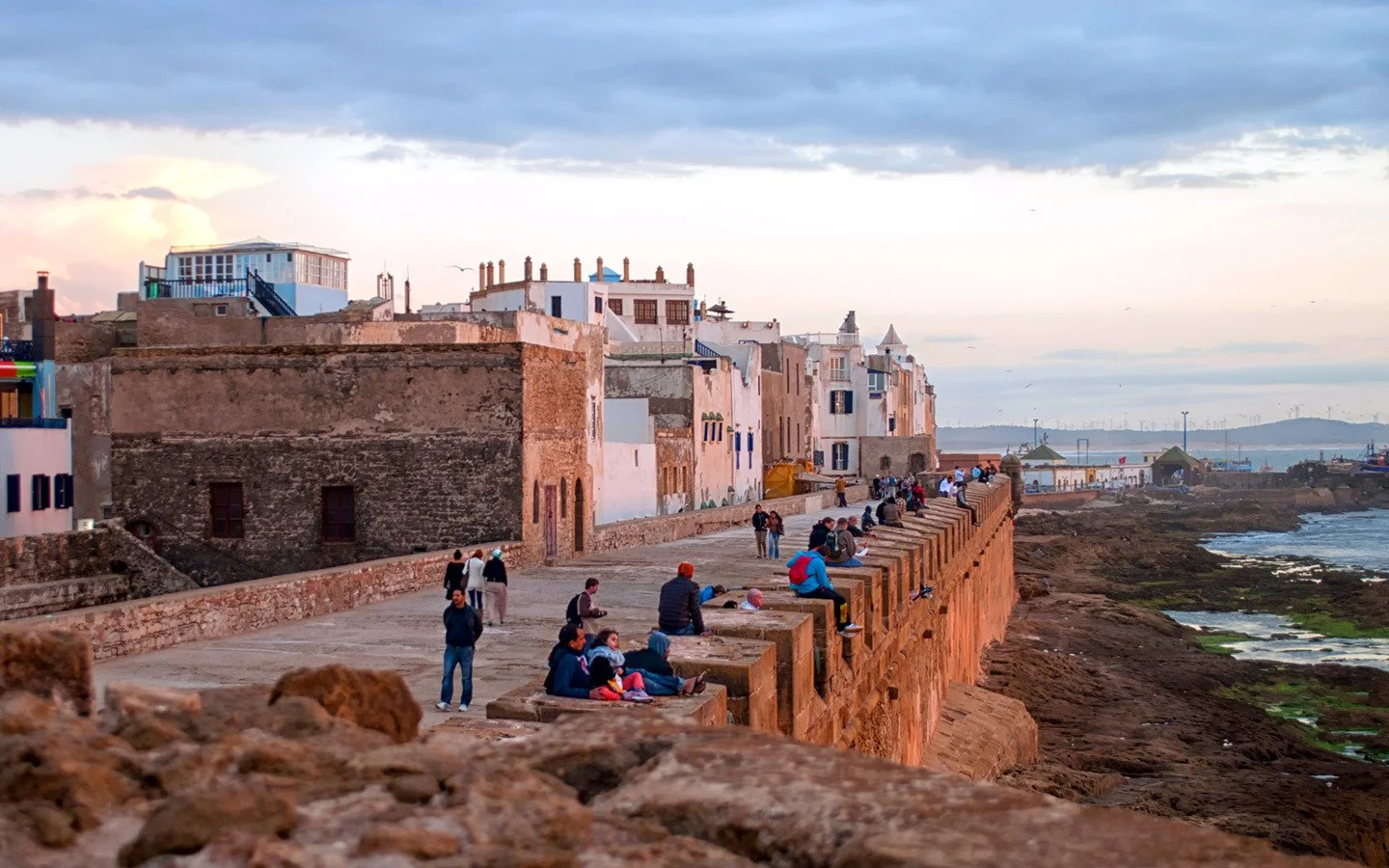
Perched on Morocco’s Atlantic coast, Essaouira is a cross between North Africa and the Mediterranean. Surrounded by golden-stone city walls, it mixes bright blues and dazzling whitewash with flowing djellabas and the smell of spices. Influences from the Arabs, Africans, Romans and French all blend together to create a mellow, relaxed beach town.
Add in 300 days of sunshine and warm but not sweltering temperatures, and you’ve got the perfect short break destination. Although Essaouira doesn’t have tons of must-see sights, it’s an easy place to spend a few relaxed days, whether just as a weekend break or part of a longer Morocco itinerary. So here are my favourite things to do in Essaouira.
The best things to do in Essaouira, Morocco
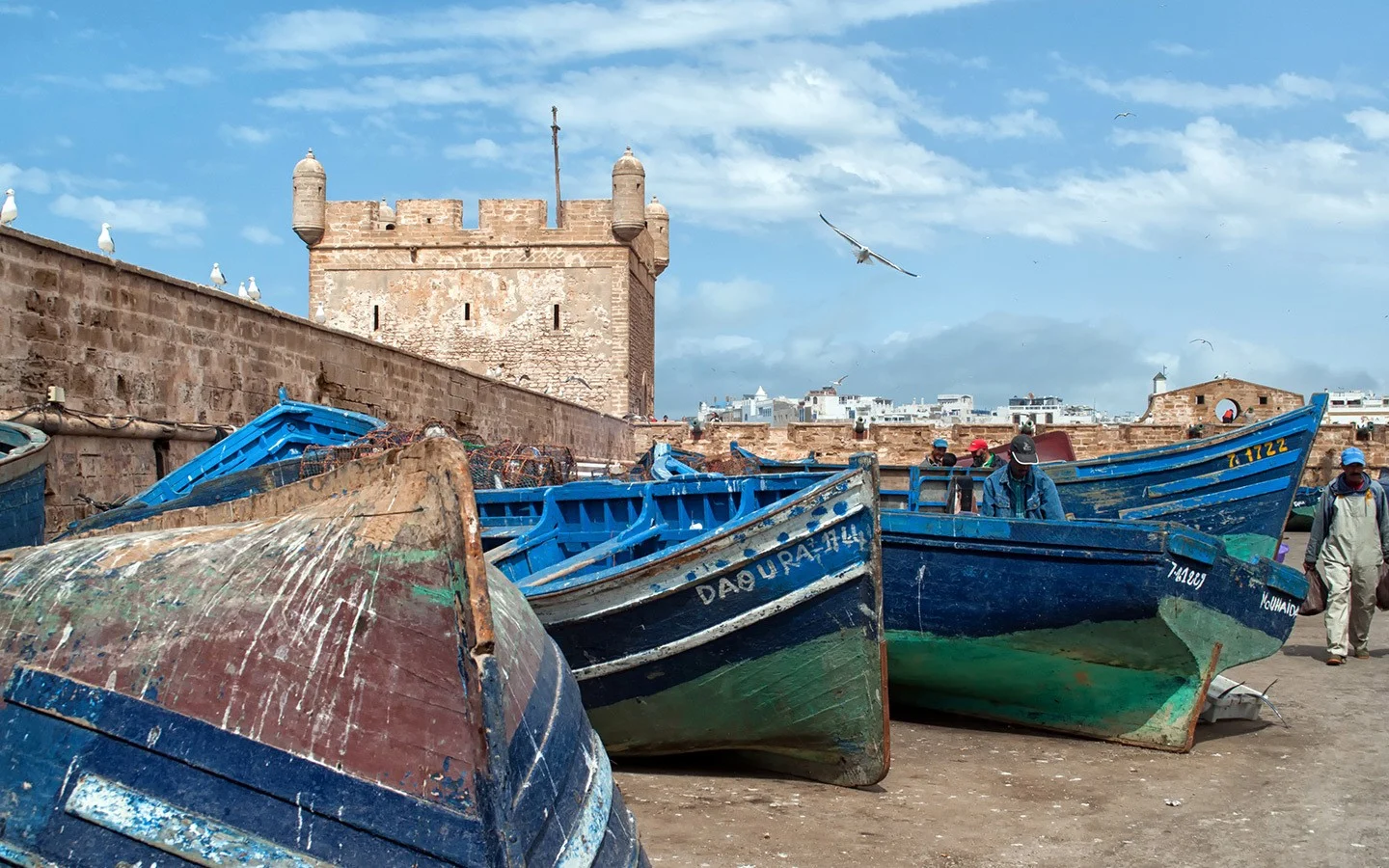
Climb Essaouira’s ramparts
Essaouira’s seafront ramparts are where the medina meets the Atlantic Ocean. These city walls were built by French military architect Theodore Cornut in the 1760s to protect the port from raiders, and took inspiration from the town of Saint Malo in France.
If you’re a vintage film fan you might recognise them from the start of the 1952 Orson Welles film Othello. The movie opens with a shot of Iago suspended in a cage over the rocks which was shot here. Or a bit more recently they were a filming location for the third series of Game of Thrones as the slave trader city of Astapor.
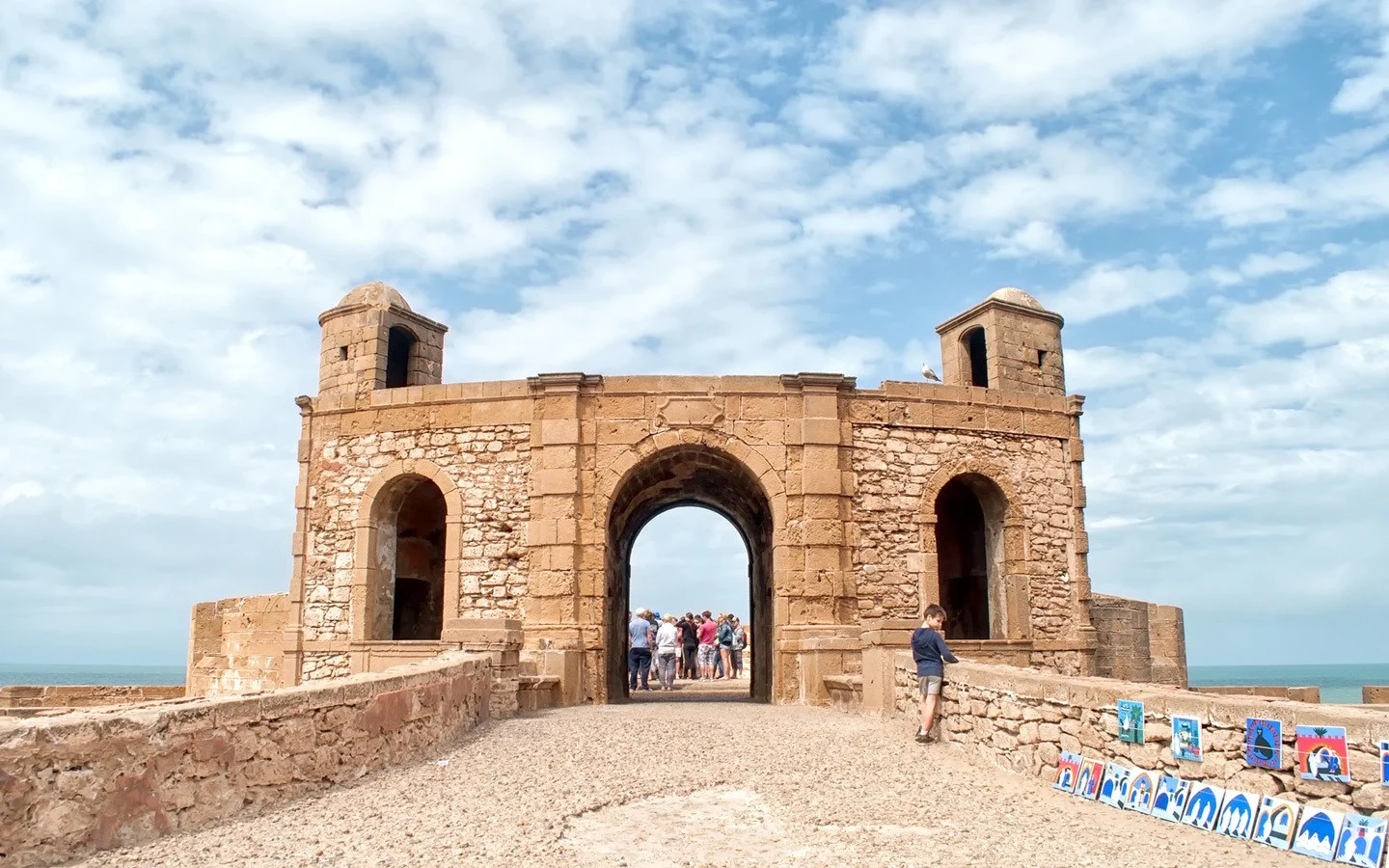
The ramparts are bookended by the impressive skala, a type of defensive bastion. At one end is the Skala du Port (also featured in Game of Thrones), which is the gateway to the fishing port. And at the other end is the Skala du Ville, and there are 19 bronze cannons lined up along the sea wall which are a good spot to watch the sun set.
There are great views across the medina and out to the ocean from the ramparts, and you’ll usually find artists and craft stalls set up along the waterfront or in the arches underneath.
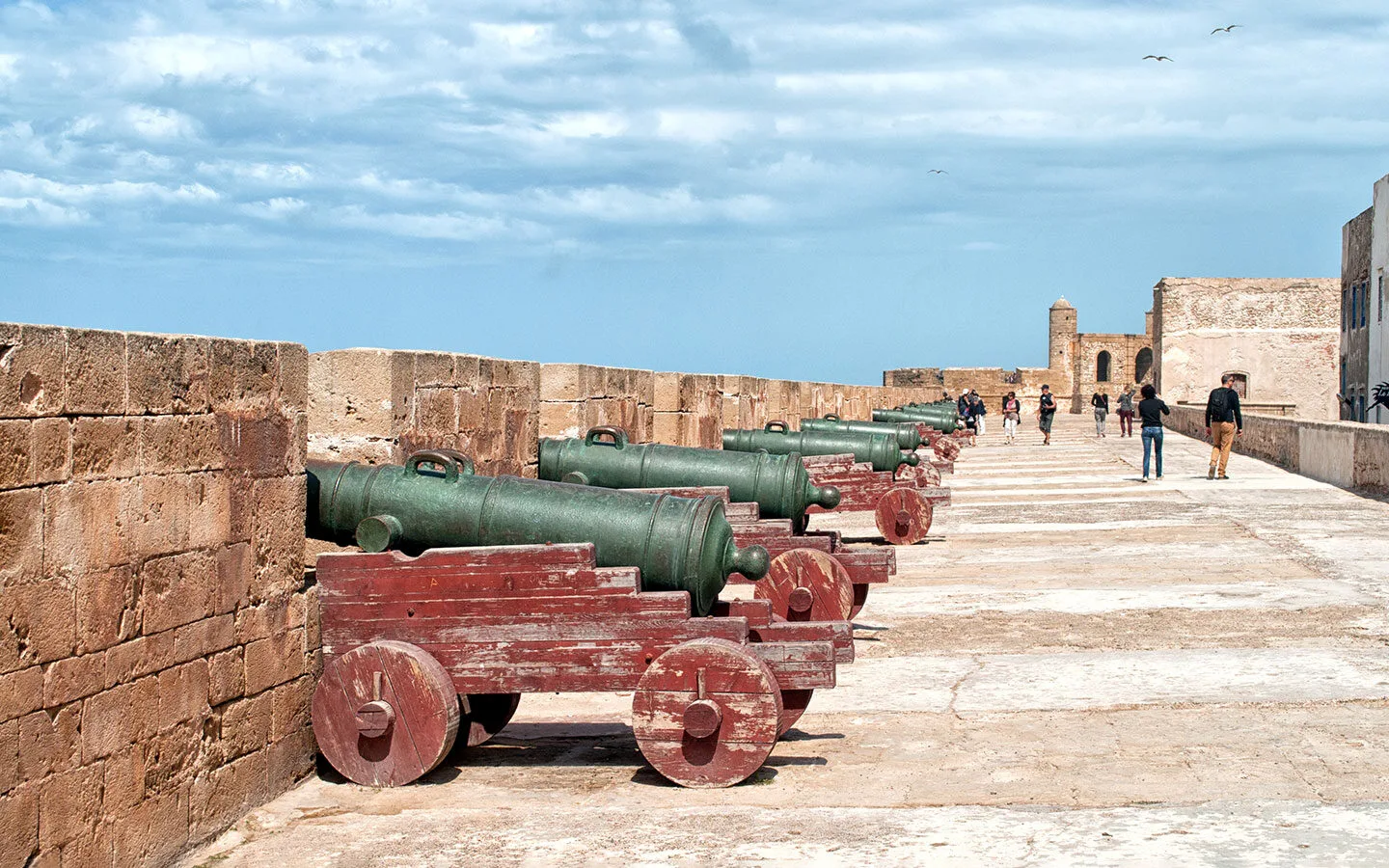
Watch the boats come in
In the 19th century, Essaouira was Morocco’s biggest port. It was known as the ‘Port of Timbuktu’ as goods like gold and spices came by caravan from sub-Saharan Africa to be shipped out to Europe and the Americas. Today the port’s cargo is a bit smaller scale as the water isn’t deep enough for big modern ships, but it’s still a bustling place.
Watching the fishermen at work is one of the most popular things to do in Essaouira. You can see them mending their nets and the shipbuilders at work repairing or building the traditional blue wooden fishing boats which are still used today.
Between 3pm and 5pm, the fishing boats come in for the day and the fishermen auction off their catch. You can watch the bargaining going back and forth. Or pick up some fish or seafood – including sardines, crabs, mussels and eels – and have it grilled at stalls along the edge of the port. The hordes of seagulls and stray cats fight it out for any leftovers.
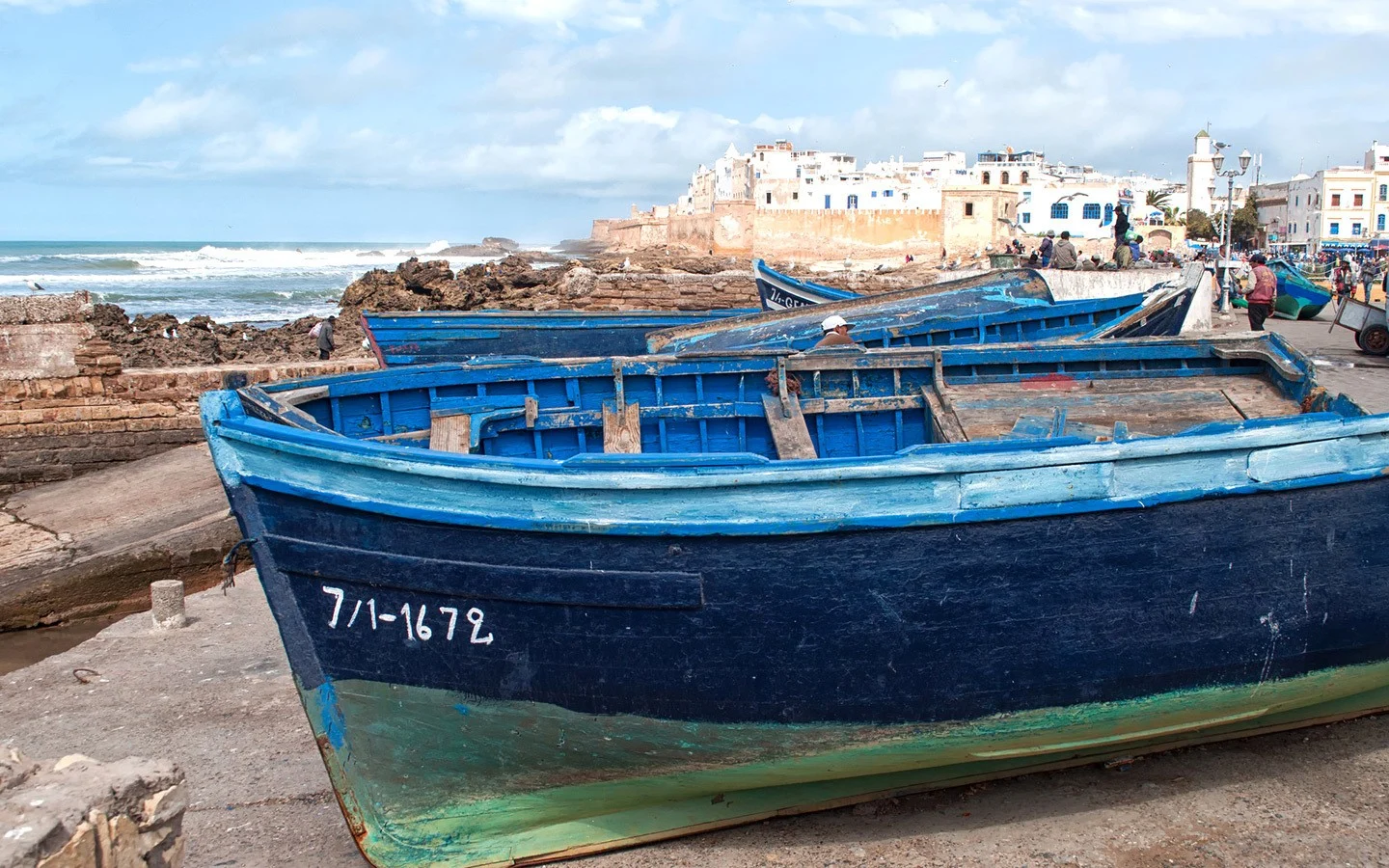
Blow the cobwebs away on the beach
Essaouira has been nicknamed the windy city, and it’s partly justified. But it’s not necessarily a bad thing, as the trade winds blowing into the bay keep temperatures down to a more reasonable high 20s°C in summer while the rest of Morocco is sweltering.
If you don’t mind a light sandblasting you can still get a dose of beach time. The city’s main beach stretches for 1.2 miles/2km south of the medina, with a paved pathway running alongside it. It’s wide and flat, with sunbeds available for hire.
Most beach-goers opt for something a bit more active than sunbathing though. The wind brings big waves to the shallow waters of the bay which is perfect for surfing* or kitesurfing,* and even if you don’t have a go it’s impressive to watch. You can also ride a camel* or go quad biking* on the beach, or cycle along the beachfront promenade.
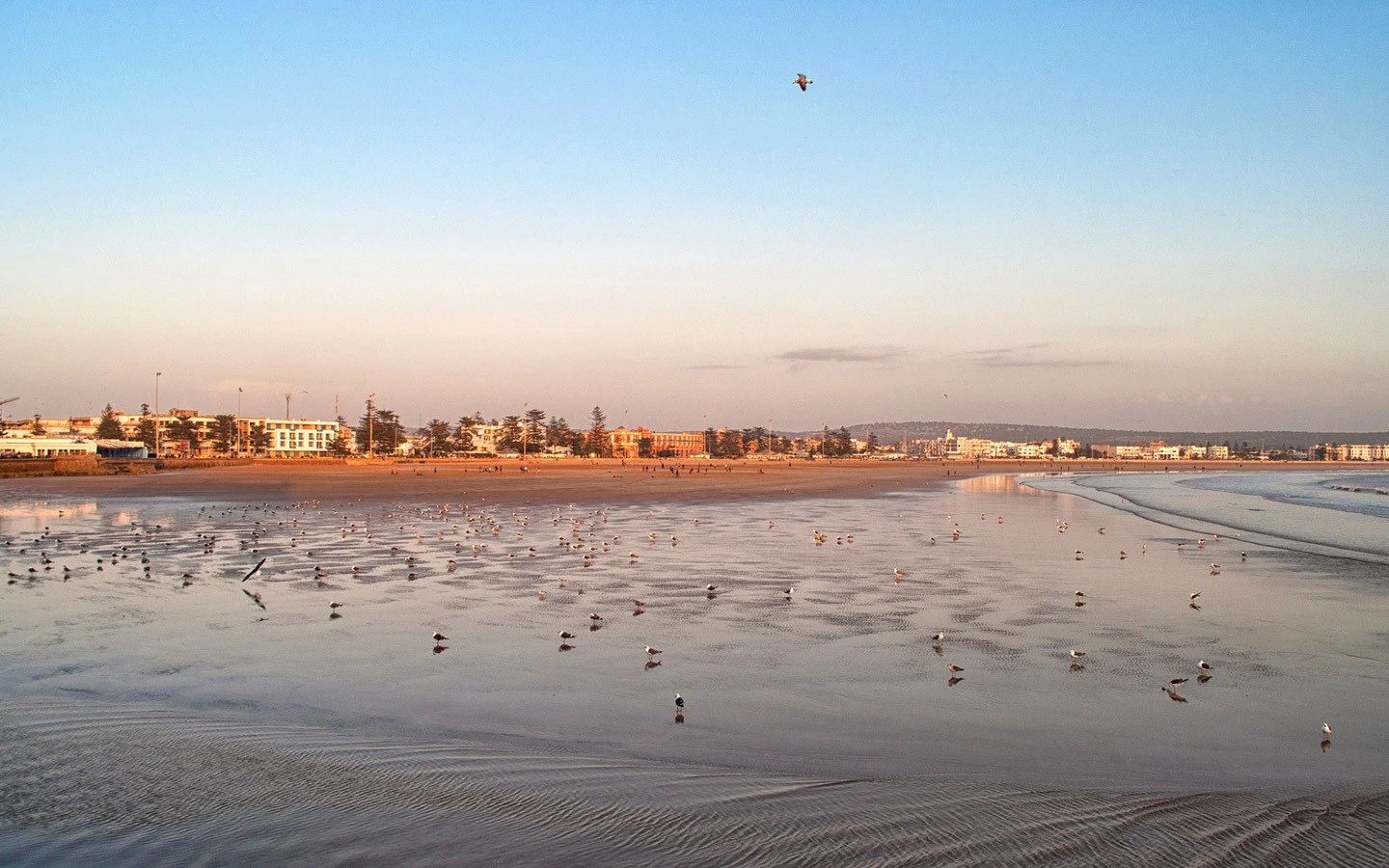
Don’t get lost in the medina
Formerly known as Mogador, the medina in Essaouira has been listed as a UNESCO World Heritage site for its unusual mix of Moroccan and European styles. But unlike the medinas in a lot of other Moroccan cities, walking into Essaouira’s medina isn’t like going into a maze, so you’ve got a pretty good chance of not getting yourself completely lost.
As you wander through narrow alleyways lined by tall whitewashed buildings there are still plenty of twists and turns, but it’s based on a French-inspired grid design which makes it easier to find your way around (apparently Es-Saouira translates as ‘beautifully designed’).
The centre of the media is Place Moulay Hassan, a big pedestrianised square where you can grab a table in one of the cafés for the perfect people-watching spot.
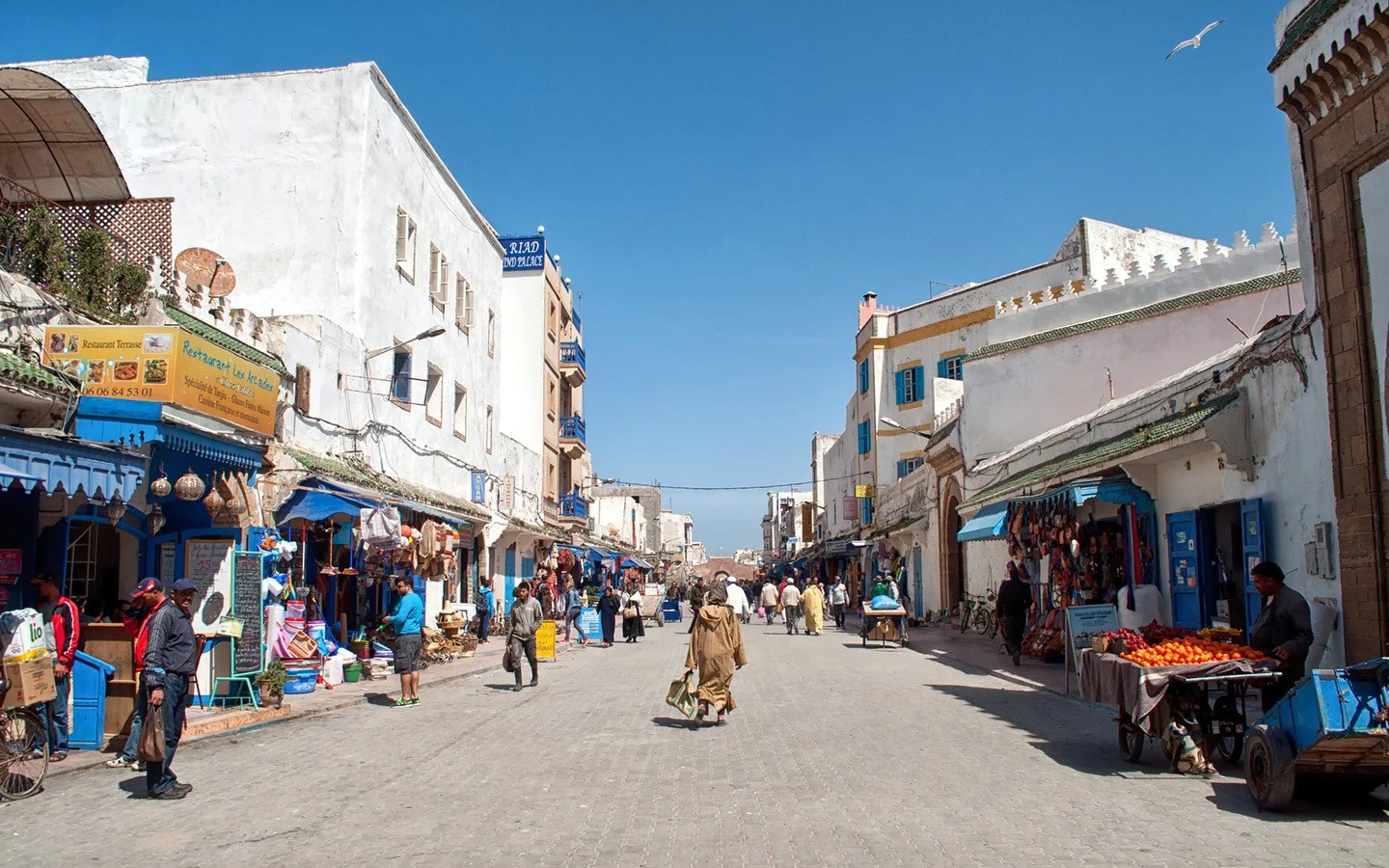
Shop the Essaouira souks
Essaouira’s small and fairly laid-back souks are a good place to practice your bargaining skills before tackling more manic versions in big cities like Marrakech.
As well as produce stalls selling fresh meat, fish and piles of aromatic spices (the custom-blended Ras el Hanout spice mixes are a good souvenir to take home), there are also souks for hand-made jewellery or made-to-measure tailoring. You can also search for treasures at the flea market in La Joutia square which takes place on Sundays.
Elsewhere in the medina you can pick up gifts like local artworks, argan oil from nearby cooperatives, silver ornaments from the Jewish silversmiths, ornate marquetry boxes and furniture carved from thuya wood, and the mysterious lotions and potions concocted by the Berber pharmacists. Just don’t forget to barter on the prices.
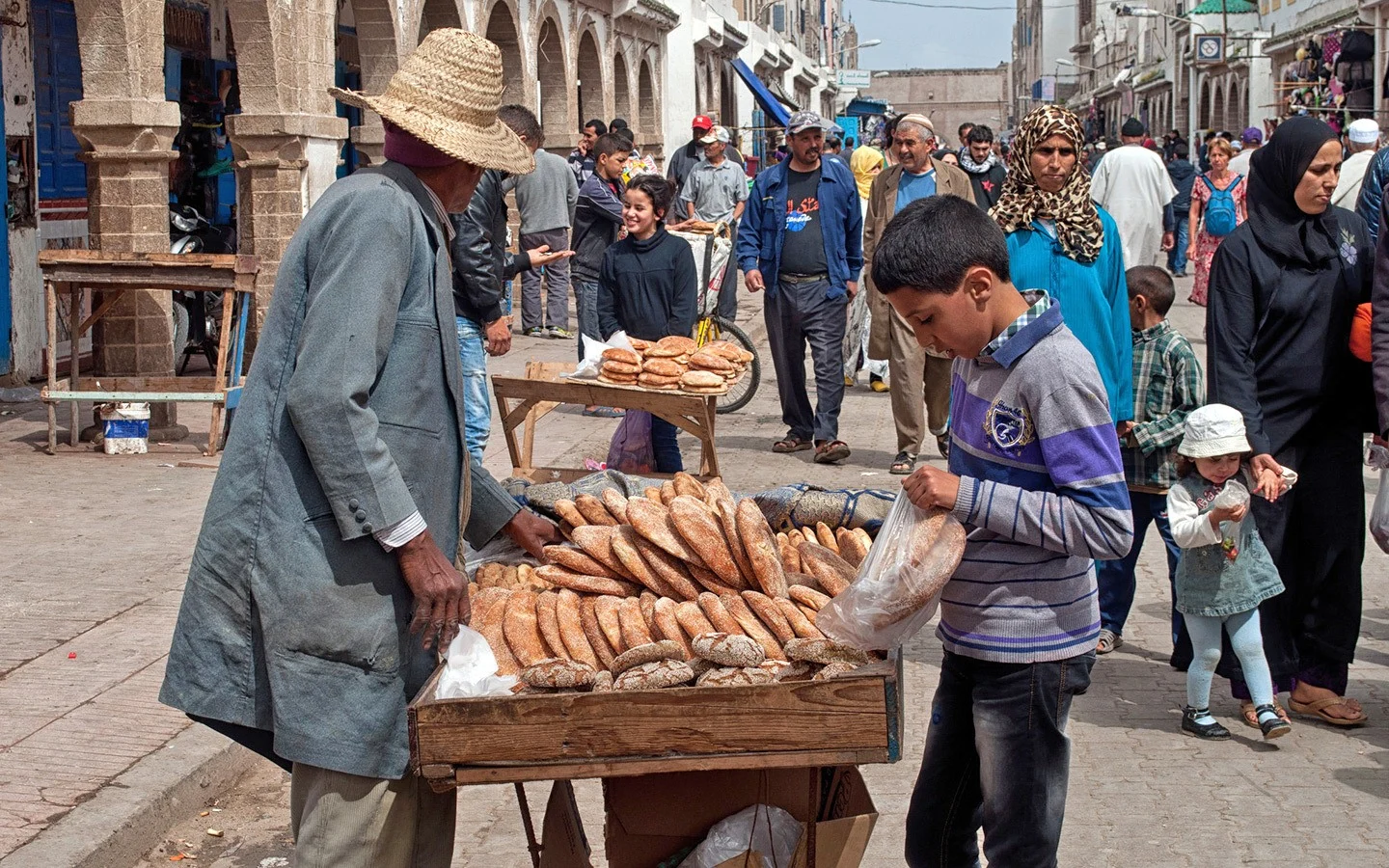
Listen to live music
Gnawa music is massively popular throughout Morocco, but Essaouira is its heartland. This type of music originated in Senegal, Sudan and Ghana, and was brought to Morocco by slaves. It mixes spirituality, rhythm and wild dancing, building up into a hypnotic trance.
Gnawa used only three instruments – krakets (iron castanets), ghimbri (a three-stringed bass) and voice. You can hear it at Gnawa Blues or the Café Des Arts in Essaouira, or there’s an annual Gnaoua World Music Festival each June. As well as Gnawa, there’s also the Festival des Alizés in April with performances of classical music, or the Festival des Andalousies Atlantiques in November which features Arab and Andalucian music.
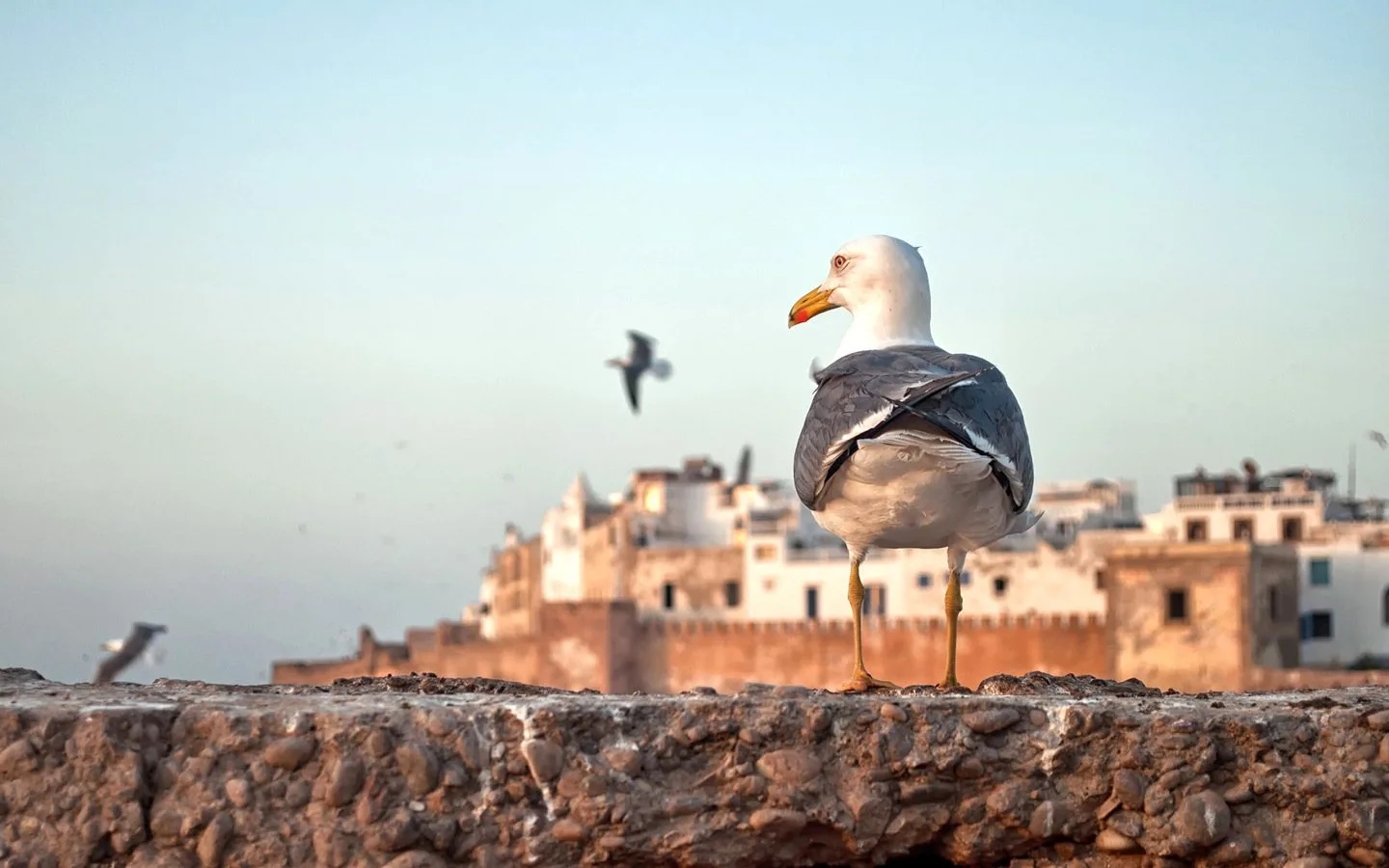
Learn to cook Moroccan food
One of the best ways to take a taste of your holiday home is to learn to cook some local dishes. L’Atelier Madada cookery school offer half-day classes in both French and English under the arches of a former almond factory converted into a modern kitchen.
Groups of up to eight people learn to cook a two-course meal with local chef Mona. She is the latest in a long lineage of dadas – female chefs who worked as private cooks for rich families in the past and run the kitchens in many of the best riads today.
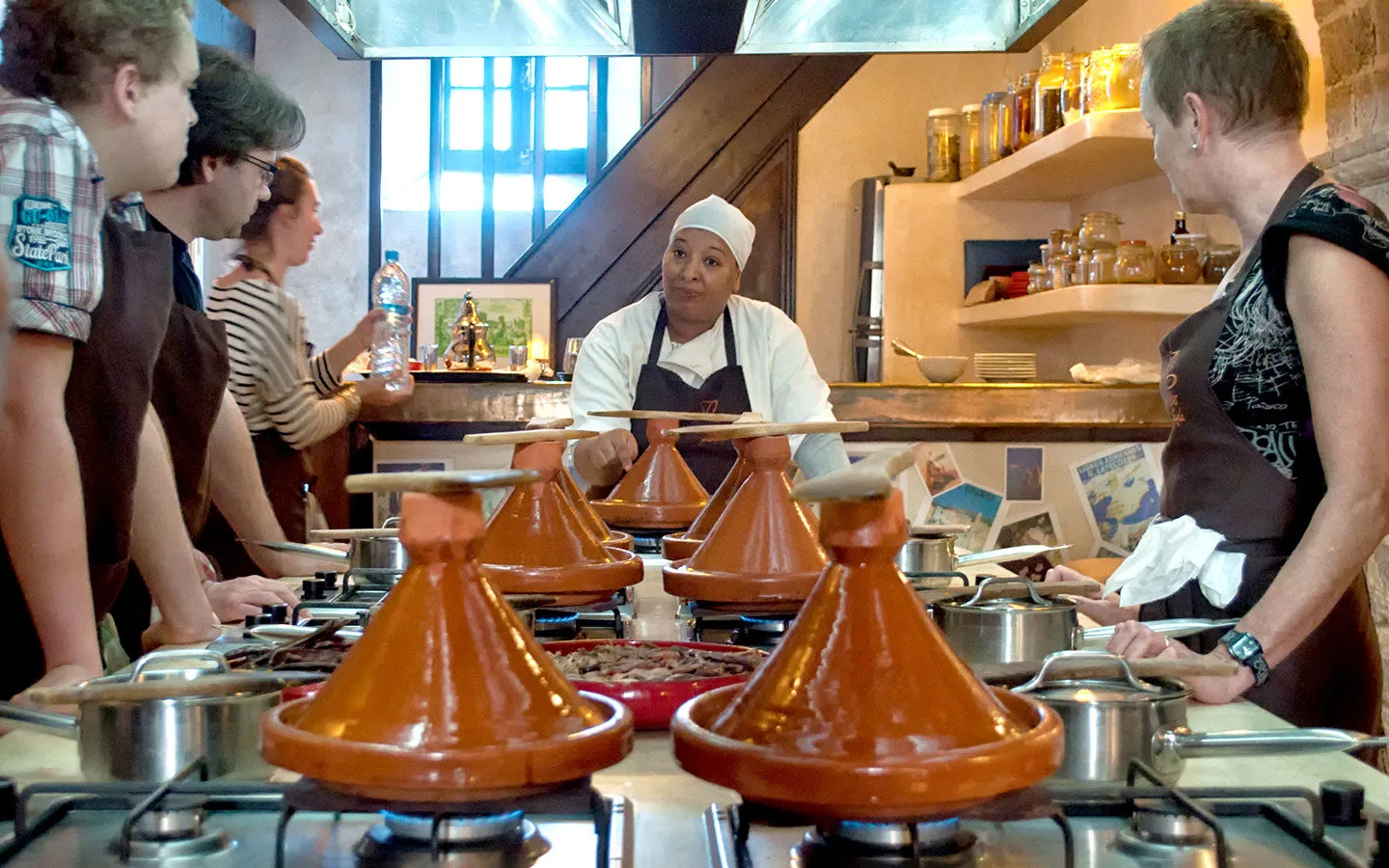
The day starts with a lesson in how to make a proper Moroccan mint tea. Then whoever books in for that day first gets to choose what you cook, and you can pick from a range of traditional tagines, as well as other dishes like pastilla (a pie made with layers of puff pastry), zaalouk (an aubergine salad) or briouates (triangular stuffed pastries).
While it’s cooking you take a tour around the market’s spice souks to learn more about the spices used, including ras el-hanout – custom spice blends for different types of dish which can include up to 30 different spices. Then the day ends with a feast of the food you’ve created – chicken and olive tagine in our case – and recipe cards to take home.
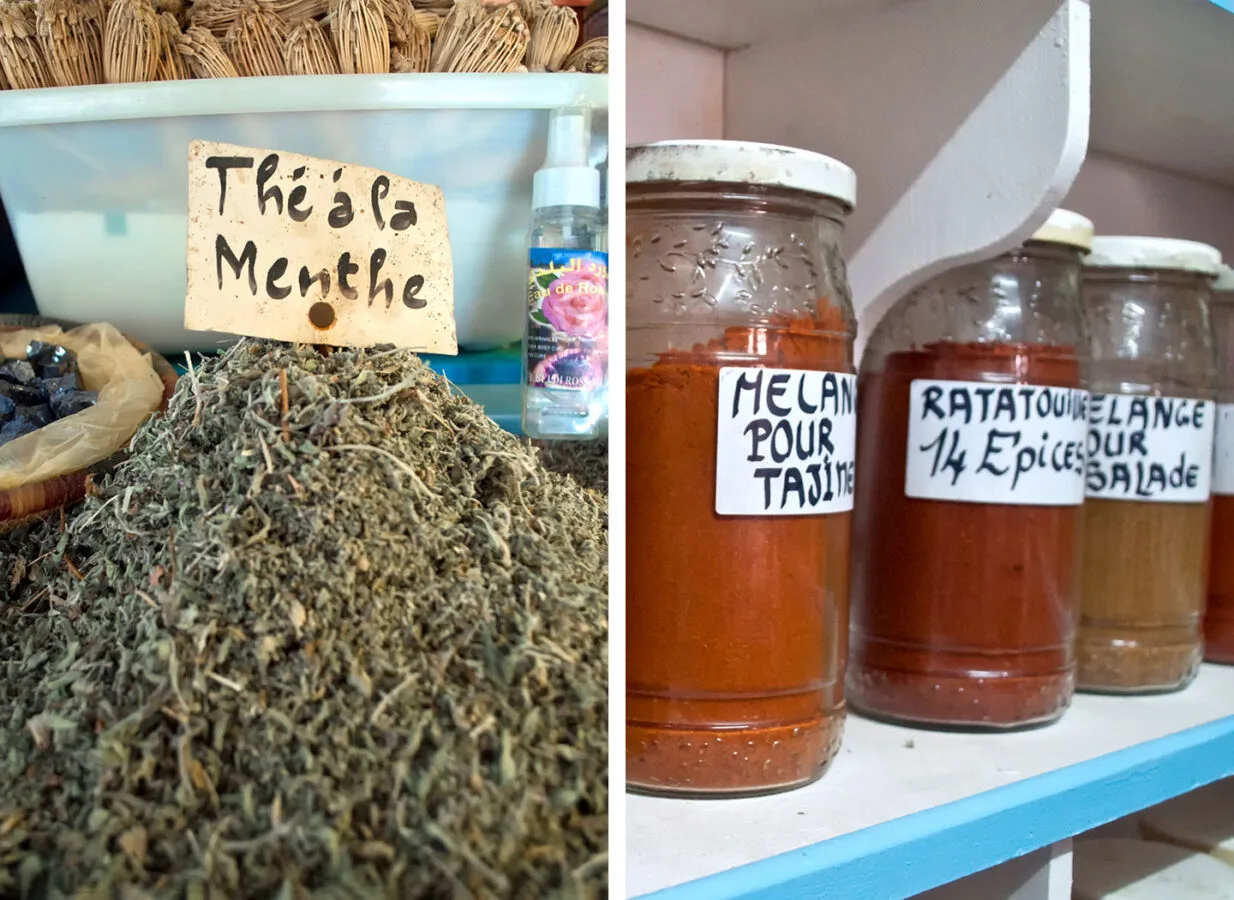
Or just eat your way around Essaouira
If cooking your own dinner sounds like too much hard work, you can just go on an eating spree around the city instead. In the port and fish souq you can pick up freshly caught fish and seafood and have it cooked for you, washed down with fresh orange juice.
Recommended restaurants worth a visit include La Table by Madada (Rue Youssef El Fassi) for classy Moroccan food and tapas in romantic candlelight, bohemian Caravane Café (Rue du Qadi Ayad) for rum punch and local dishes, Gusto Italia for Italian seafood (Rue Charif El Idrissi) and Triskala Café (Rue Touahen) for organic vegetarian and vegan food.
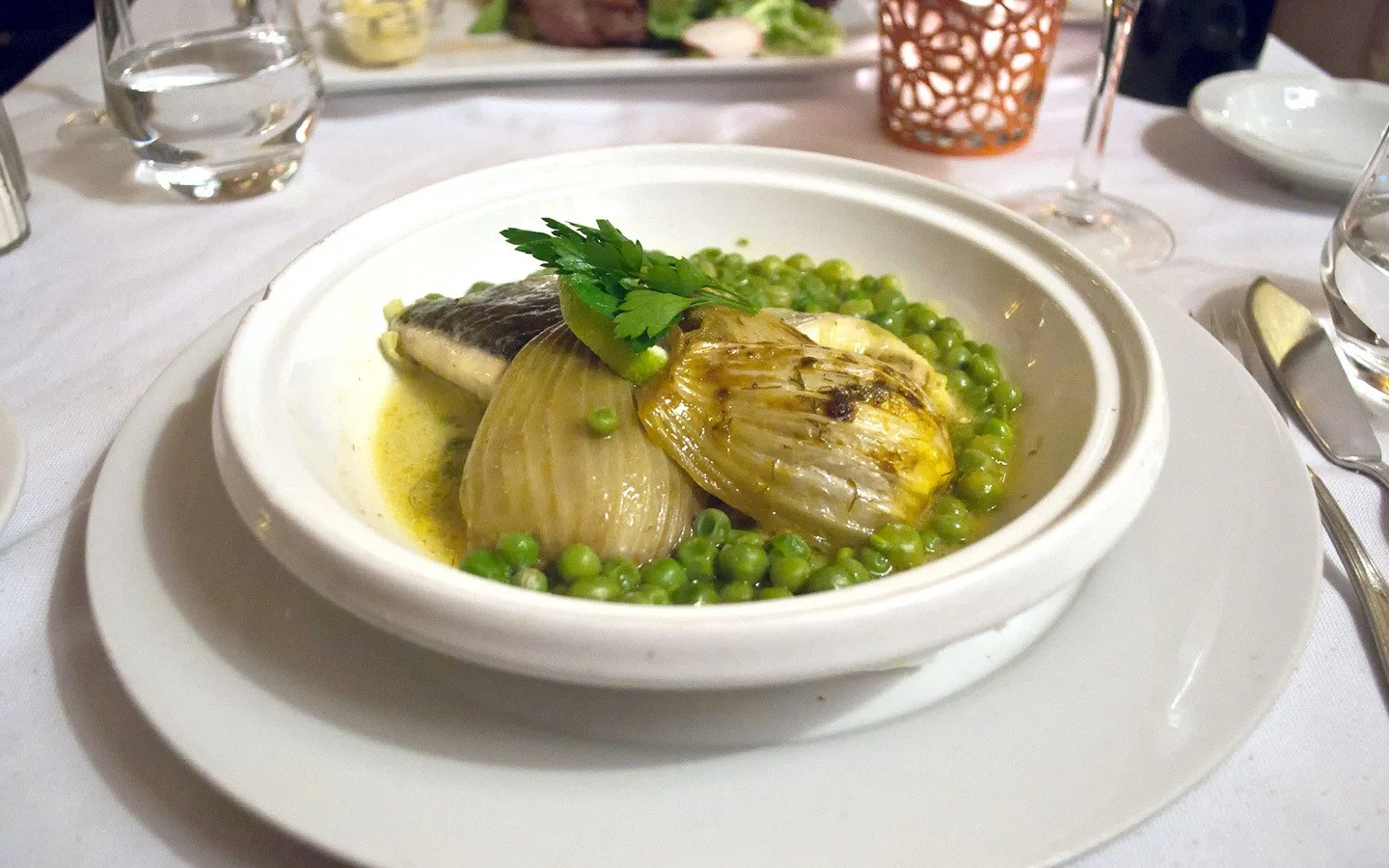
Catch a stunning Essaouira sunset
Essaouira’s west-coast location makes it a great place to watch the sun slowly dipping down into the water. Looking out across the Atlantic from the city on a clear day you get a spectacular light show at dusk, with the fading sun making the stone of the ramparts glow gold and the fishing boats and seagulls silhouetted against the light.
Grab a prime spot along the city walls or head up onto a rooftop bar for a prime sunset viewing spot – there’s Taros Bar in Place Moulay Hassan and the bar at the Salut Maroc hotel in the medina, or the Roof Top Bar overlooking the beach.
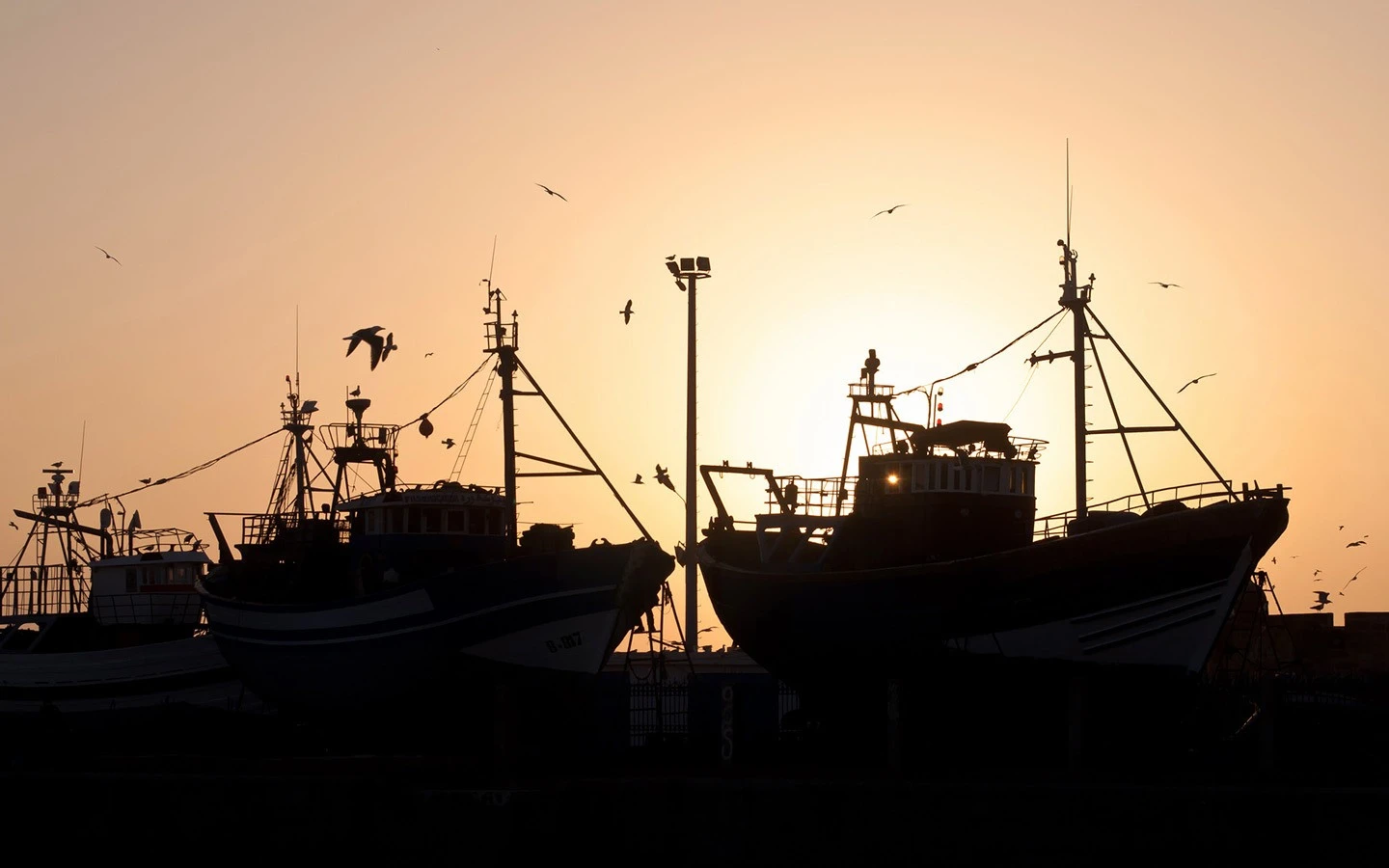
The details
When to visit Essaouira
Essaouira’s coastal location means it has a maritime climate – making it a lot less extreme than places like Marrakech with their 39ºC (102ºF) summers. Essaouira gets 300 days of sunshine a year, so it’s a popular destination for a winter break.
Temperatures in January and February are mild, with average daytime highs of 18ºC (64ºF) and nighttime lows of 13ºC (55ºF). November to March sees a bit more rainfall than the rest of the year, but that’s still only a couple of days a month on average.
Summer is peak season and has the hottest weather, with average highs of 28ºC(82ºF) in July/August. But Essaouira isn’t known as the ‘Windy City of Africa’ for nothing. It can get very blowy, with gusts of over 30mph/50kmph in summer. The winds normally start to drop from September and it’s calmest from then until November.
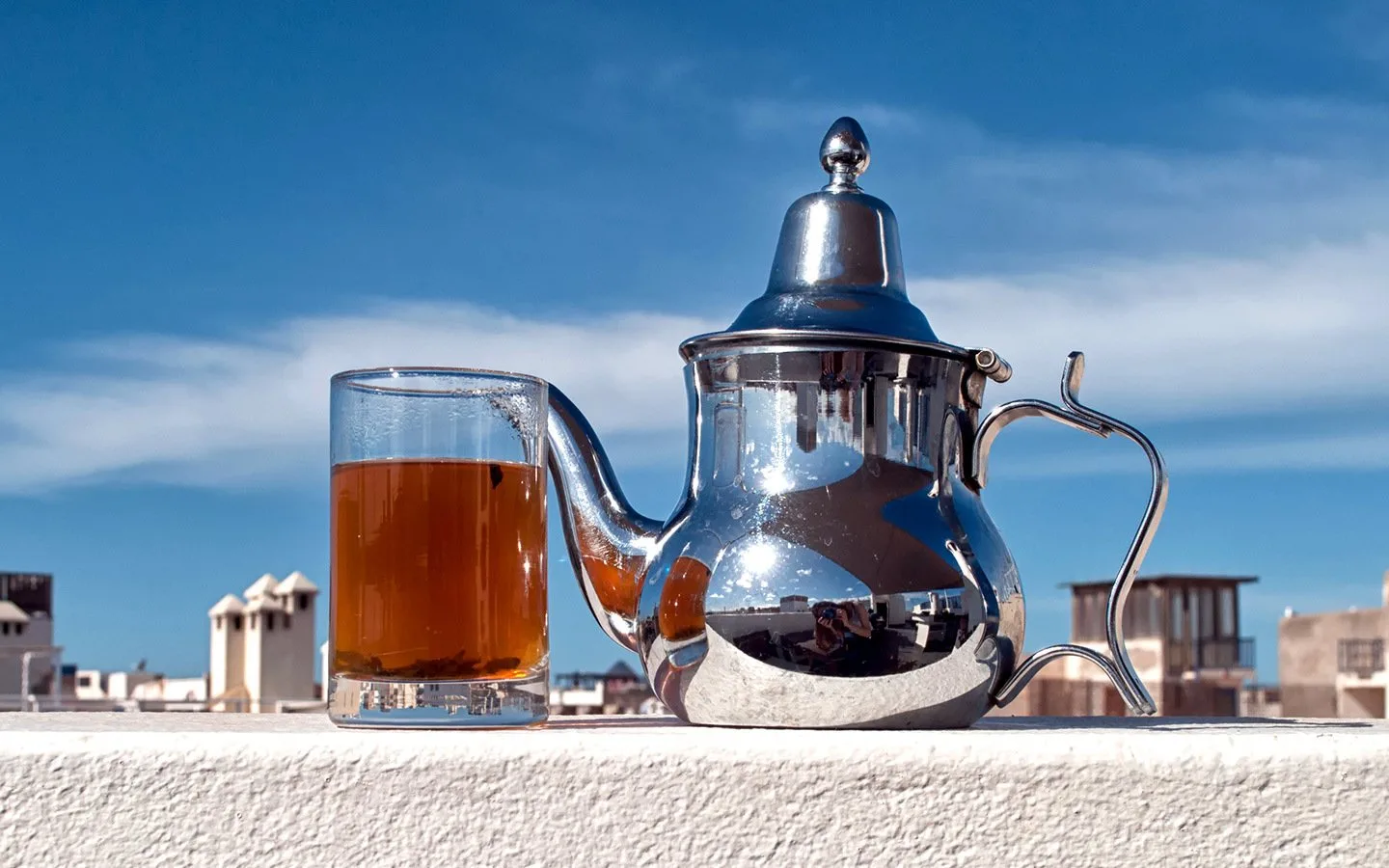
How to get to Essaouira
Essaouira has a small airport which has direct flights from Paris and Brussels, and seasonal flights from London Stanstead and Marseille with Ryanair – though they’re not very frequent. Essaouira airport is 10 miles/16km outside of the city centre and you can take a bus, shuttle or taxi (which costs around 150 MAD/£12/$14) between the two.
It’s more common to travel to Essaouira from Marrakech though, where you’ll find the nearest major airport. Marrakech to Essaouira is 115 miles/180km or 2.5 hours’ drive.
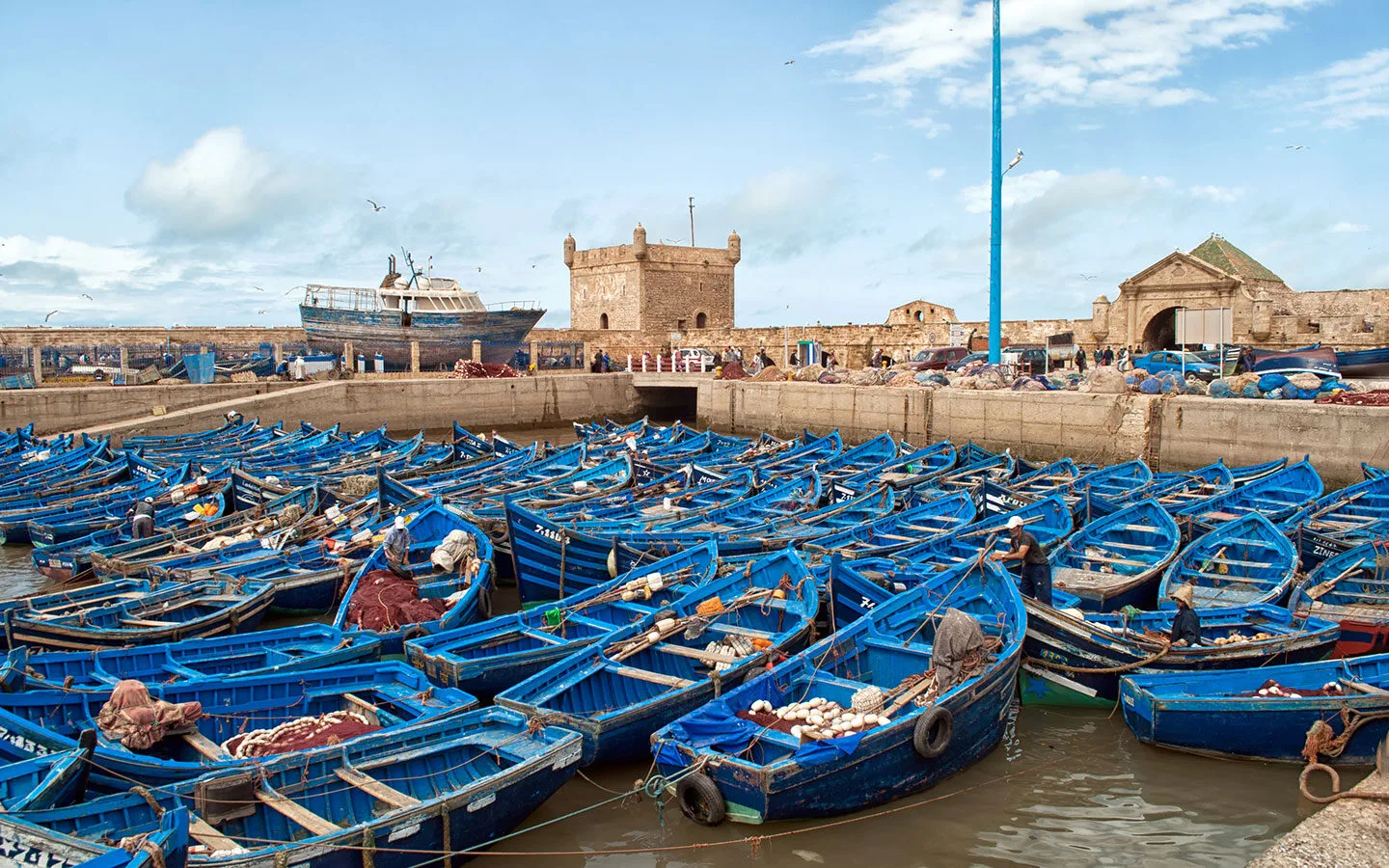
You can hire a car in Marrakech and drive yourself, book a taxi or private transfer*, or take the bus. Buses run from the Supratours bus station in Marrakech several times a day, though they can get very busy so get there early or book in advance online. The journey takes around 3 hours (with one stop) and costs 95–115 MAD (£8–9/$9–11).
If you’re staying in the medina in Essaouira, buses and cars can only go as far as the gates, so you’ll need to carry your luggage to your hotel. Or if you’ve got heavy bags, you can hire a porter with a luggage cart to transport your bags for you.
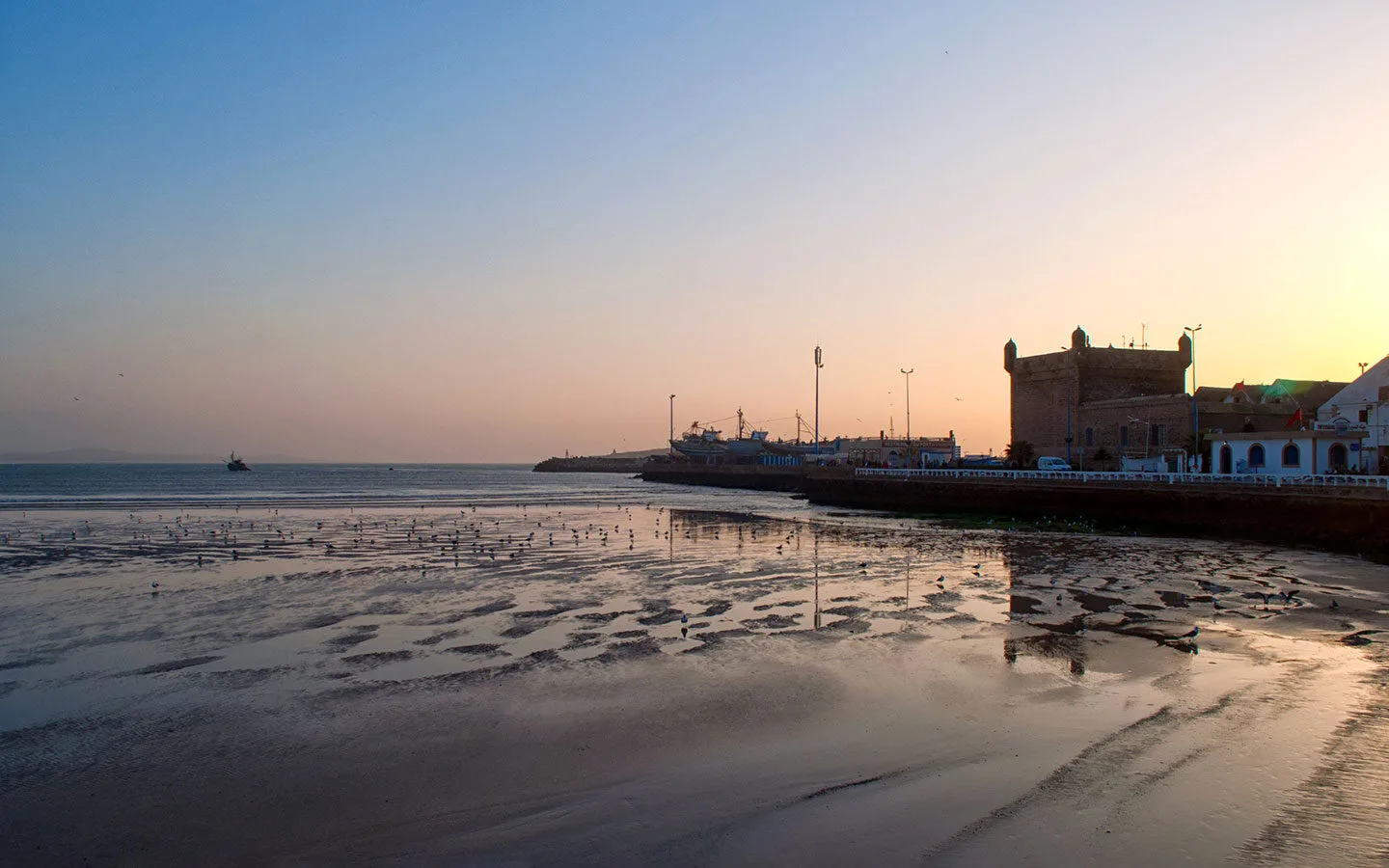
Where to stay in Essaouira
Riad Dar Maya* is a boutique hotel with just five rooms, tucked away in the medina. It was rebuilt from derelict so combines a traditional riad design with modern comforts. Rooms have tadelakt polished plaster walls, marble bathrooms with underfloor heating and open fires. And there’s a sea-view rooftop terrace with dip pool, courtyard and hammam.
Or the Madada Mogador* looks out over the medina walls to the beach. There are seven bedrooms, ranging from standards to sea-view suites, and a communal lounge, library and big roof terrace with comfy wicker sofas where you can watch the sunset. It’s also home to the excellent La Table Madada restaurant and l’Atelier Madada cookery school.
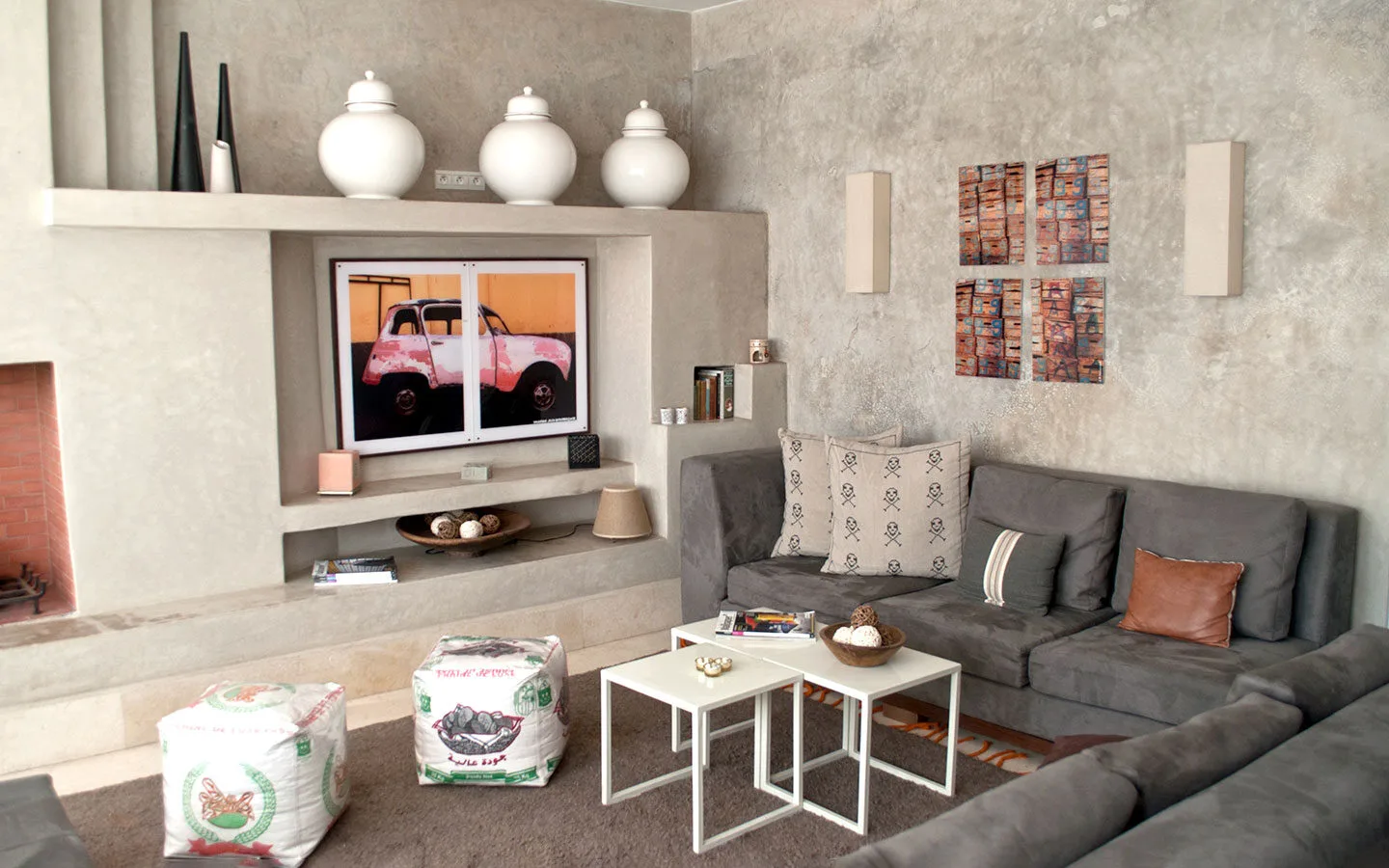
Save for later
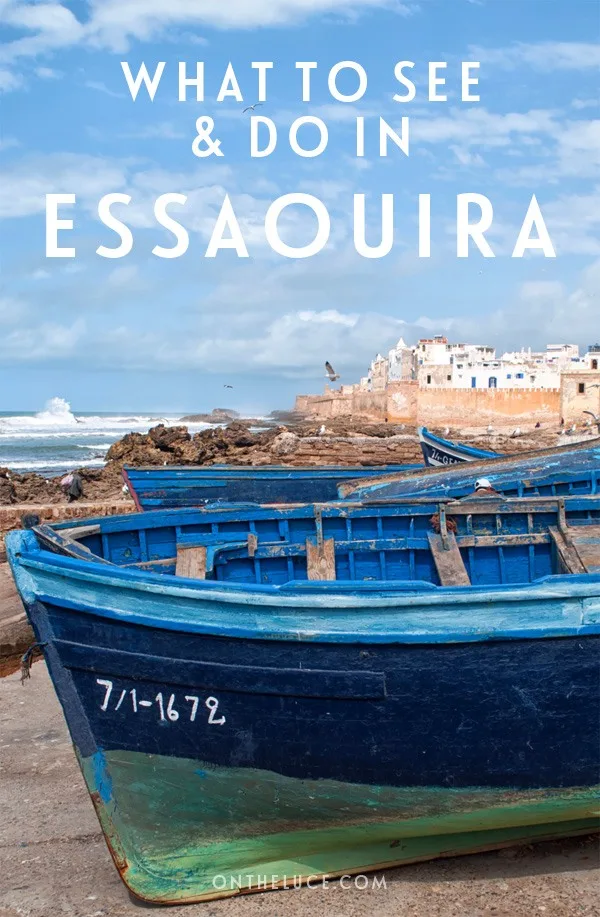
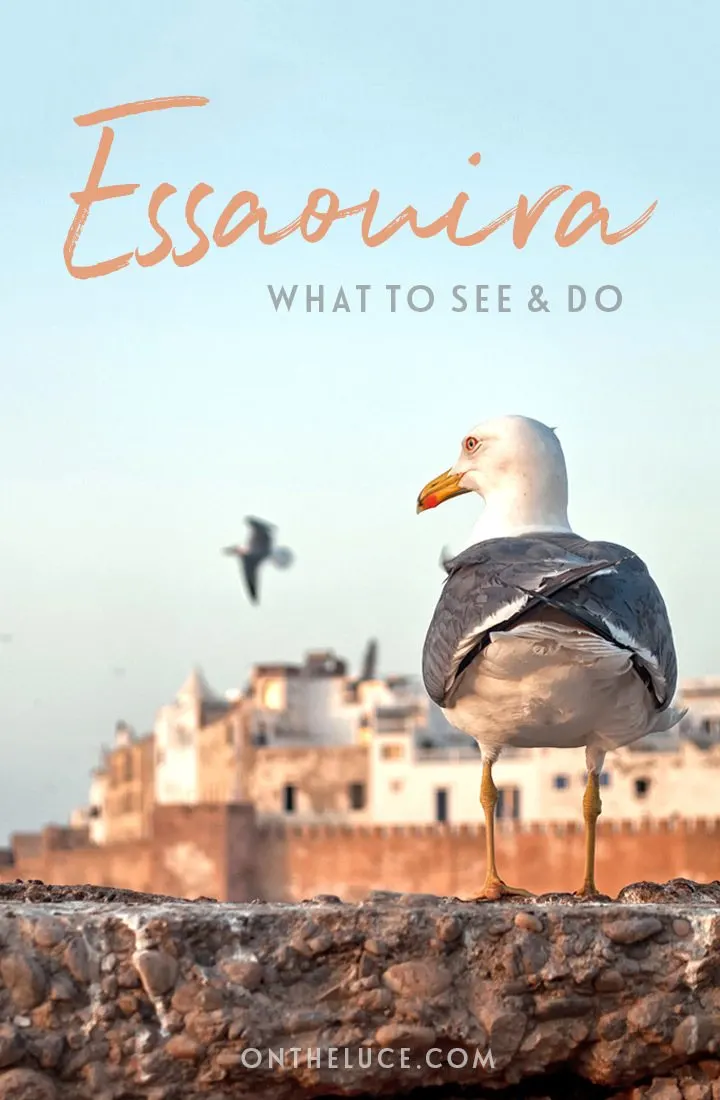

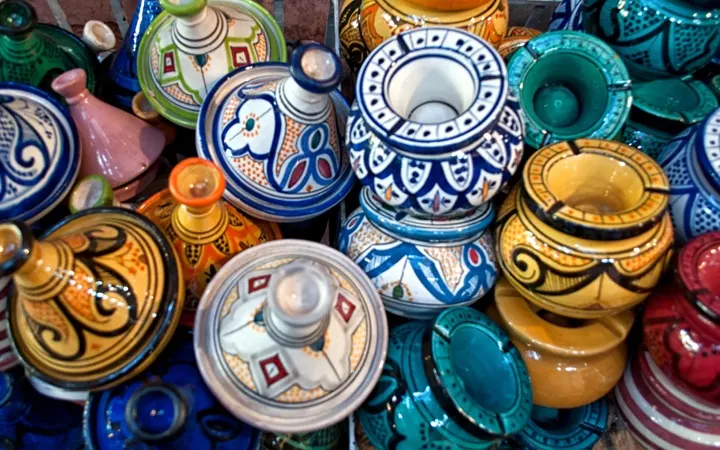
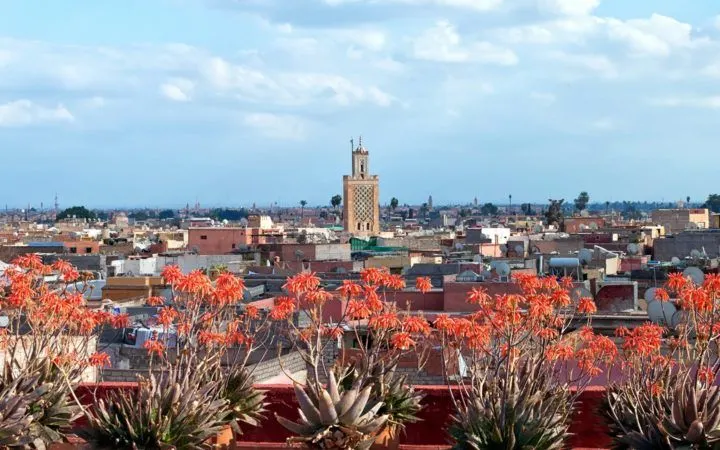
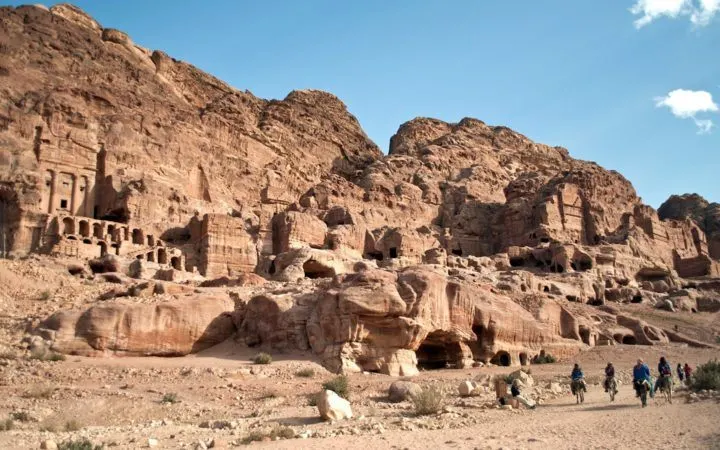
Beverly Neun
Tuesday 1st of August 2023
I spent 5 or 6 weeks during the summer of 1970 in Essaouira with friends. We rented rooms that shared the kitchen and bathroom with our landlord family. Rooftop out the window were chickens. Now I want to return with my family. Where should we stay for a few days? Hopefully some place authentic. Thank you
Lucy Dodsworth
Monday 7th of August 2023
Sounds like a great experience! I would definitely recommend staying in a riad in the old town, I loved Riad Dar Maya but you could also try Chems Bleu for something a bit more traditional.
Peter Andrew
Thursday 28th of March 2019
Essaouira is the most charming and vibrant port and resort town .It is the best holiday destination to experience the true culture of morocco due to its laid back life style. whats your say about visiting Essaouira in june for Gnaoua Music Festival, i heard its too much crowded with tourists.
Lucy
Saturday 30th of March 2019
It's a lovely place – I've not been for the festival but I hear it is really busy.
Nada
Monday 25th of February 2019
I’m most interested to visit Morocco's beautiful people, countryside, architecture, food, fashion, decor and beauty.
Lucy
Monday 25th of February 2019
It has a lot to offer!